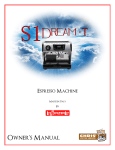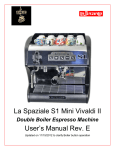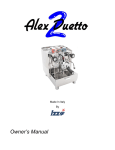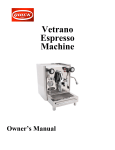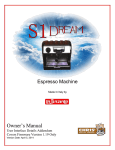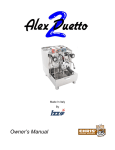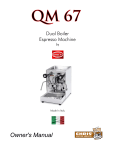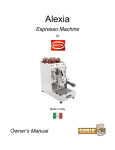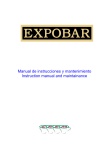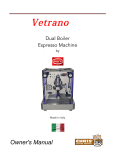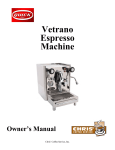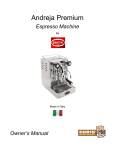Download Chris Coffee Service Silvano Owner`s manual
Transcript
Silvano PID Controlled Espresso Machine by Made In Italy Owner’s Manual Silvano Espresso Machine Diagrams .................................................................................................................................. 2 Introduction .............................................................................................................................. 3 First Time Set Up ..................................................................................................................... 3 Before Each Use ...................................................................................................................... 5 Normal Operation .................................................................................................................... 5 Gauge ....................................................................................................................................... 5 Lights ........................................................................................................................................ 5 Switches ................................................................................................................................... 6 Pump......................................................................................................................................... 6 Water Reservoir ....................................................................................................................... 7 Drip Tray ................................................................................................................................... 7 Accessories ............................................................................................................................. 7 PID Controller .......................................................................................................................... 8 Changing Brew Temperature .................................................................................................. 8 PID Controller Advanced Settings ......................................................................................... 9 Brewing Espresso ................................................................................................................. 10 Quantity of ground coffee ..................................................................................................... 10 Tamping.................................................................................................................................. 10 The grind ................................................................................................................................ 10 Consistency ........................................................................................................................... 10 Cleaning Tip ........................................................................................................................... 10 Steaming Milk - Basics .......................................................................................................... 11 Milk.......................................................................................................................................... 11 Temperature ........................................................................................................................... 11 Frothing Pitcher ..................................................................................................................... 11 Amount of Milk ....................................................................................................................... 11 Stretching the milk ................................................................................................................ 11 Texturizing the milk ............................................................................................................... 11 Steaming Milk – Technique................................................................................................... 12 Steaming Milk - Tips .............................................................................................................. 13 Maintenance ........................................................................................................................... 13 Backflushing .......................................................................................................................... 13 Plain water backflushing....................................................................................................... 13 Backflushing with espresso machine cleaner .................................................................... 14 Setting Pump (Brew) Pressure ............................................................................................. 14 Setting Pump Pressure On Older Models............................................................................ 14 Group Gasket Replacement.................................................................................................. 15 Shower Screen Removal ....................................................................................................... 15 Descaling................................................................................................................................ 16 Troubleshooting .................................................................................................................... 16 No Steam From Steam Wand ................................................................................................ 16 Not Heating ............................................................................................................................ 17 Espresso Coming Out Too Slow Or Not At All .................................................................... 18 Espresso Coming Out Too Fast ........................................................................................... 18 Warranty ................................................................................................................................. 19 We Are Here To Help ............................................................................................................. 19 1 Silvano Espresso Machine Diagrams 1. PID Controller 2. Pump (Brew) Pressure Gauge 3. Grouphead 4. Portafilter 5. Drip Tray 6. Cup Warming Tray 7. Water Reservoir 8. Steam Wand 9. Steam Tip 10. 3 Position Power Switch 0 – Off 1 – Fill Mode (Coffee Boiler Off) 2 – Heating/Normal Operation Mode 11. Brew Switch 12. Steam Switch 13. Power Indicator Light 14. Coffee Boiler Heating Light 15. Steam Bank Heating Light 16. Steam Bank Power Switch 17. Power Cord Receptacle 18. Double Portafilter 19. Cleaning Brush 20. Backflush Disc 21. Single Insert Basket 22. Coffee Tamper/Scoop 2 Silvano Espresso Machine Introduction First of all, thank you for your business! You are going to love your new Silvano espresso machine. It combines classic beauty, value, and the latest PID technology to provide great performance for making the best espressos, cappuccinos, and lattes you‟ve ever tasted! These instructions include tips that will help bring out the Barista that‟s hidden within! First Time Set Up Warning: It is very important to follow the first time set up procedure below or damage to the coffee boiler heater will occur which will not be covered under warranty. Before using your machine, test your water for hardness using the provided test strips. Fill a glass with cold tap water; dip the tip of the test strip into the water for one second, then pull the strip out of the water and hold it horizontally for fifteen seconds. After fifteen seconds, compare the color of the strip to the chart on the side of the package to determine how many grains of hardness is in your tap water. Three grains or less of hardness is acceptable to be used in the machine. Note: Should your water‟s hardness level exceed three grains, then it is strongly recommended to use a different source of water that has been tested for hardness. Some bottled water can be extremely hard and should always be tested before using. Using a Brita or PUR style pitcher or faucet filter does NOT remove any hardness from the water and should only be used in the machine if your water source is under 3 grains of hardness. Using hard water in the machine will affect its performance and may cause damage to the machine which is not covered under warranty. Remove the water reservoir from the machine and rinse thoroughly before use. Fill the reservoir with cold soft water being careful not to overfill. Return the reservoir to the machine and slowly push it in to avoid splashing water into the machine. Be sure that the long tubes shown in the picture to the right are at the bottom of the reservoir and they are not kinked. The short tubes should hang into the reservoir as shown and will discharge a small amount of water whenever one of the pumps are engaged. 3 Silvano Espresso Machine First Time Set Up, Continued Before plugging the machine in be sure that all three of the switches on the front of the machine are in the off position. Machines with the 3 way power switch, LEFT is the off position for the brew and steam switch. Machines with a standard on/off switch, RIGHT is the off position for the brew and steam switch. Plug the power cord into the receptacle in the back left of the machine and then plug the other end into a grounded 3 prong 110V outlet. Do not plug the machine into an extension cord or adaptor. The use of a GFI outlet is strongly recommended. The machine may be placed on a timer as long as it is rated for 110V 15A and is 3 prong and grounded. Turn the power switch to the “1” position and then activate the brew switch to fill the boiler. For older machines with a standard on/off switch, turn the power switch to the on position and then Immediately activate the brew switch to start filling the boiler. The pump will turn on to start filling the coffee boiler and water will start coming out of the grouphead. Keep the brew switch on for an additional 15 seconds after water starts coming out of the grouphead to assure that the boiler is completely filled and then turn off the brew switch. After filling the boiler turn the power switch to the “2” position to start heating. Lock the portafilter into the group head with either the single or double basket installed, whichever you intend to use. The coffee boiler heating light will illuminate and the temperature on the PID display should start rising. The coffee boiler should get up to temperature in about 5 minutes, but it is recommended that the machine be heated for at least 15 minutes for better temperature stability. If you plan on steaming milk then turn on the steam bank power switch in the back left of the machine. The steam bank should be ready to use in less than 5 minutes. The steam bank can be turned on and off independently from the coffee boiler to conserve energy if you do not plan on steaming milk. It is advised to always keep the portafilter in the grouphead and your espresso cups on the top cup warming tray. An espresso shot is very small so if any part is cold it will greatly affect the quality of the shot and can make it taste sour. You are now ready to start pulling some shots! 4 Silvano Espresso Machine Before Each Use Verify the steam and brew switch are in the off position. Fill the reservoir with cold softened water. Place the portafilter into the grouphead and then turn the power switch to the “2” position. Let the machine warm up for at least 15 minutes for optimal performance. Normal Operation Gauge The gauge is for your pump (brew) pressure. When sitting idle the gauge is reading trapped pressure and may vary. To get an accurate pump pressure reading, install the backflush disc in the portafilter and lock it into the grouphead and raise the brew lever. After a few seconds the pressure should rise to about 9-10 bar. When you make espresso the pressure will be slightly less which is normal. This can be helpful in setting your grind. If your pressure is 9-10 bar with the backflush disc, but when you make espresso it is less than 8 bar then you need to go finer with your grind which will create more resistance to raise the pressure. Should you need to adjust the pump pressure please refer to the maintenance section of the owner‟s manual. Lights On the front of the machine there are 3 indicator lights. The green power light on the top will illuminate when the main power switch is on. The amber coffee boiler heating light in the middle will illuminate whenever the coffee boiler is heating. The light will cycle on and off to maintain the temperature in the coffee boiler. The amber steam bank heating light on the bottom will illuminate whenever the steam bank is heating. The light will cycle on an off to maintain temperature in the steam bank. The steam bank power switch on the back of the machine must be in the on position for it to function. 5 Silvano Espresso Machine Switches There are 3 switches on the front of the machine. The top switch is the main power switch. When the power switch is on, the green power indicator light will illuminate. There are 3 positions for the power switch. 0 is off, 1 is fill mode, and 2 is heating mode for normal operation. The fill mode is used for the first time set up, if the machine has not been used for a long time, or if the boiler has been drained. Older style machines have a standard on/off switch. The switch in the middle is the brew switch. The brew switch is used to activate the pump for brewing espresso. Activate the switch to start the shot and when the shot has reached the desired level then turn the switch off to stop the shot. The bottom switch is to activate the steam wand. The steam bank power switch on the back of the machine must be on to create steam. Turn the steam switch on to start steaming and when you are done turn the steam switch off to stop. Be sure the steam tip is still below the milk surface when you turn it off or splashing can occur if you remove the tip while the steam is still activated. After turning the steam switch off, remove the wand from the pitcher and hang it into the drip tray or into a cloth and then turn the switch on and off for a second to blow out any trapped milk in the steam tip and then immediately wipe the steam arm down with a damp cloth to prevent milk from drying on the steam arm. In the back of the machine is the steam bank power switch. This switch is used to turn the steam bank on and off independently from the coffee boiler. If you regularly steam milk then the switch can be left in the on position. If you do not steam milk regularly and want to conserve energy then the switch can be turned off. Pump The machine is equipped with two vibratory pumps. Vibratory pumps can be loud by nature and their tone may change during the course of a shot which is normal. Both pumps are equipped with a klixon thermal fuse for protection. Should the pumps run for an extended period of time the klixon will kill power to the pump and then will restore power once it has had time to cool off. The larger pump is used for brewing espresso. The pump pressure is regulated by an expansion valve. Should you need to adjust your pump (brew) pressure then please refer to the maintence section of the manual. There is also a smaller pump that is used for steaming. The steam pump pressure is not adjustable. 6 Silvano Espresso Machine Water Reservoir The water reservoir is located in a cut out on the right side of the machine. Only cold soft water should be used in the reservoir. When refilling the reservoir be careful not to over fill it and then slowly push it back into the machine being careful not to splash any water inside. There are four tubes that go into the reservoir. The longer tubes have a screen on the end which may need to be periodically cleaned. The shorter tubes will discharge a small amount of water into the reservoir whenever the pump is engaged which is normal. The reservoir should be cleaned at least once a week with mild dish detergent and rinsed thoroughly before use. DO NOT PUT IN DISHWASHER!!! Depending on your water quality it may be necessary to periodically sanitize the reservoir or if you are using hard water and have a mineral build up inside. White vinegar can be used to sanitize and will also remove the mineral deposits that can accumulate. Fill the reservoir with white vinegar and then let it sit for an hour and then rinse and clean the reservoir thoroughly. If the reservoir still has a vinegar taste or odor you can mix some baking soda and water in the reservoir to remove the taste and odor and then clean it normally. Drip Tray The drip tray should be periodically emptied and cleaned. It may be cleaned with mild dish detergent. It should not be used in a dishwasher. If hard water marks accumulate in the drip tray it can be cleaned with vinegar. On the right side of the drip tray there is a discharge tube that comes from the group solenoid valve. Whenever you turn off the brew switch a small amount of water will be discharged into the drip tray to relieve the pressure in the grouphead which is normal. Accessories The machine ships with a double portafilter which can be used with either the single or double insert basket. It also comes with a backflush disc, group head cleaning brush, and a coffee tamper and scoop. 7 Silvano Espresso Machine PID Controller The PID controller uses the latest technology to provide a more stable and accurate brewing temperature to bring out the best taste characteristics of the coffee you are using. It also gives you the option to easily change the brew temperature to match different coffee blends and experiment with the different tastes that are brought out at various temperatures. The PID controller has been configured for optimum performance and should not require any adjustment other than the temperature. The default temperature has been set to 200, but can be easily changed to match the coffee blend you are using The temperature shown on the display may vary from the set temperature while heating or pulling a shot and is normal. As long as the machine has had adequate time to warm up then the temperature hitting the coffee will be consistent with the set temperature despite the variance shown on the display. Changing Brew Temperature To change the brew temperature with the machine on, press and release the down arrow key. When the display reads PrG, press and release the up arrow key to display the set temperature. Use the arrow keys to change to the desired temperature. After a few seconds the display will revert back to normal operation. The recommended brew range is between 195°- 205° Fahrenheit or 90°- 96° Celsius. The hotter the temperature the more it will bring out the bitter sweet chocolate tones. Going too hot may make the shots taste very bitter. The colder the temperature the more it will bring out the fruity tones. Going too cold may make the shots taste sour. Feel free to experiment with different temperatures to bring out different tastes in the coffee you are using. 8 Silvano Espresso Machine PID Controller Advanced Settings These instructions will allow the user to change the temperature from Fahrenheit to Celsius as well as other advanced settings. It is not recommended to change the advanced settings unless the user has a thorough understanding of how a PID controller operates. To change the advanced settings, with the machine turned off hold down both arrow keys and then turn the main power switch on. When F.03 appears on the display then release the arrow keys. Press the up arrow key to select and change the existing setting. After changing a setting you must wait a few seconds for the display to revert back and then you can press the down arrow key to cycle to the next setting. To save the new settings turn the machine off and then back on again. ADVANCED SETTINGS Fahrenheit Or Celsius Mode Proportional Value Integral Value Derivative Value Offset (temperature between boiler and group) DISPLAY F.03 P I D F.04 DEFAULT SETTINGS F C .5 3 0 .05 3 2 25 12 The PID calculation algorithm involves three separate constant parameters, the proportional, integral, and derivative values. These values can be interpreted in terms of time: P depends on the present error, I on the accumulation of past errors, and D is a prediction of future errors based on the current rate of change. These 3 settings work together to determine when and how to apply power to the heating element. The PID controller allows for a more precise temperature control than a traditional thermostat or pressure stat controlled system. It also enables you to quickly and easily change the brew temperature to match your personal tastes. The offset is the difference between the temperature drop from when the water leaves the coffee boiler and then hits the coffee. This setting has been calibrated using a Scace device and should not be changed. To learn more about PID controllers please visit the link below. http://en.wikipedia.org/wiki/PID_controller 9 Silvano Espresso Machine Brewing Espresso First let me begin by explaining the three main variables of preparing great espresso. 1. Quantity of ground coffee 2. Tamping 3. The grind Quantity of ground coffee - Loosely fill the basket slightly mounding over the top. Then lightly run your finger arched across the basket from left to right, right to left, front to back, and then lay your finger flat on the basket and go from back to front to remove any excess coffee. This technique helps fill any voids in the basket to help achieve an even extraction. Tamping - After filling the basket with coffee then use your tamper to apply 30lbs of pressure evenly on the coffee bed. Then without applying any pressure lightly twist the tamper on the bed of coffee to “polish” the loose grounds on top. Then lock the portafilter firmly into the group head and then activate the brew switch to start the extraction. When it has reached the desired level, turn off the brew switch to stop the shot. It is very important to tamp consistently with the same pressure each time or your shot quality and timing will vary. The grind - Adjust your grind so that when you activate the pump, the flow of coffee coming out of the portafilter spout looks like the tapered tail of a mouse. It should take approximately 25 seconds for a 2 oz. double shot. If it is coming out quicker then the grind needs to be adjusted finer, if it is coming out slower or not at all then the grind should be adjusted coarser. The grind particle size should look in between powder and salt. Not as fine as powder, but not as coarse as salt. Getting the right grind is crucial to making delicious espresso with thick rich crema. Consistency - The quantity of ground coffee and tamping pressure should always be the same. Using more or less coffee or tamping lighter or harder will greatly affect the outcome and timing of the shot. If the shots are not coming out properly then the only variable that should be changed is the grind. Cleaning Tip: Get into the habit of disposing of the spent grounds immediately after brewing espresso. After disposing of the grounds, return the portafilter to the group head and activate the brew switch for a few seconds to rinse away excess oils and loose grounds. By regularly following this procedure, you will greatly reduce the tar-like buildup on the shower screen that occurs if you allow coffee oils to dry and bake on the hot group. A cleaning brush has also been included to clean the group screen and gasket. 10 Silvano Espresso Machine Steaming Milk - Basics First, let‟s talk about some of the things you need to learn in order to become „barista-like‟ in your techniques. Milk – Whole milk works best to steam, both in technique and in flavor! Lower fat milks contain mostly water which will not foam well and will be almost tasteless when steamed. After all your hard work you will be left with a less than desirable tasting beverage. Temperature – Your whole milk needs to be as cold as possible to ensure the creamiest, sweetest, and best tasting micro-foam. Once the milk has reached a temperature between 150-160 degrees, you must stop the process. The longer amount of time you have with the cold milk gives you that extra time to continue making the milk creamy and sweet tasting. Milk heated above 160 degrees will be burnt and taste terrible. Frothing Pitcher – Keeping your pitcher in the freezer is another tip which helps keep the milk its‟ coldest. The size of your pitcher is relative to the size and number of drinks you will be preparing at the time. Our recommendation on pitcher choices would be our own “Pro Barista Steaming Pitcher” which has become the pitcher of choice of the renowned baristas who helped train Chris‟ Coffee Service in this frothing technique. These baristas felt the Pro Barista Steaming Pitcher promoted a user friendly rolling of the milk which made it simple to create thick rich micro-foam for pouring Latte Art. Amount of Milk – Too little milk in your frothing pitcher will cause splashing when you turn on the steam arm; too much milk will cause overflow and make a huge mess. The pitcher must be filled between 1/3 to 1/2 full to have the maximum capacity for properly steaming milk. If your pitcher has a spout, fill it to half an inch below where the spout starts. Stretching the milk – Refers to the initial heating of the milk and the forceful introduction of air. Stretching continues until the milk reaches an approximate temperature of 100 degrees or “body temperature” Texturizing the milk – Refers to the next phase of frothing whereby the steam wand is submerged in the milk and the pressure continues to roll the milk. This process breaks down the large air bubbles into tiny air bubbles which then creates the smooth and creamy texture that is most desirable. 11 Silvano Espresso Machine Steaming Milk – Technique Note: The steam switch in the back of the machine must be on for at least 2 minutes to generate steam. As you face your espresso machine, point the steam arm over your drip tray and activate the steam switch for a few seconds in order to purge out any unwanted water that may have collected inside the wand due to condensation – you do not want that added to your delicious beverage! Next, position the steam arm so it is facing directly toward you and slightly angle it 45 degrees from the base. Holding your half-filled steam pitcher with the handle facing you, submerge the tip of the steam wand approximately an inch below the surface of the cold milk. Your pitcher bottom should be parallel with the countertop. The steam arm should gently rest in the spout of the steam pitcher. Now slightly tilt the pitcher left, keeping the arm away from the side of the pitcher. Turn on the steam switch and position the pitcher so the tip is just below the surface of the milk. This action creates the „stretching‟ of the milk – in other words, adding air to the milk. When done properly, the sound you hear at this point resembles „sucking‟. You continue this until the milk reaches an approximate temperature of 100 degrees or “body temperature”. After your milk has reached this „body temperature‟, submerge the tip of the steam arm approximately one inch below the surface of the milk to get the milk spinning. This process continues to roll the milk over itself again and again – breaking the large air bubbles into tiny air bubbles – resulting in a new creamy and sweeter texture of the milk. When your milk has reached approximately 155 degrees or the bottom of the pitcher becomes too hot to hold then turn the steam switch off. Using a steaming thermometer is helpful when you are learning to steam milk. As you gain more experience and become more comfortable with the process you will be able to steam milk without the help of a thermometer. If you notice in the procedure above we mention temperatures and we also mention “body temperature” and the pitcher being “too hot to hold” We mention this because body temperature is 98.6 which is real close to 100 degrees and when the pitcher becomes too hot to hold the milk will be around 150 degrees. This makes it very easy to steam milk without a thermometer. You will “stretch” the milk until the pitcher becomes body temperature and then you start the “texturizing” of the milk until the pitcher becomes too hot to hold on the bottom and then you‟re all done. 12 Silvano Espresso Machine Steaming Milk - Tips When turning the steam switch off, always keep the tip under the surface of the milk for approximately 3 seconds. If you pull it out too soon, you will destroy the nice velvety micro-foam. After removing the steam wand from the milk, position it over the drip tray and then turn on the steam switch for 1-2 seconds to clean out any trapped milk inside the tip and then wipe it down with a damp cloth immediately or the milk will dry out on the steam wand and will be difficult to clean. While texturizing the milk, if you lower the tip too far into the milk you create turbulence rather than rolling. Turbulence will not make micro-foam. If there are a few bubbles in the milk after you have finished, wait 5-10 seconds to allow all the remaining bubbles to surface, then simply tap the edge of the pitcher on the counter and swirl the milk slightly and they will disappear. Be sure to keep your steamed milk moving/swirling until you are ready to pour since milk has a natural tendency to separate. Maintenance Backflushing is a vital maintenance procedure you must follow to help keep your machine running flawlessly for years to come. There are two types of backflushing; one with plain water, and the other with espresso machine cleaner. Plain water backflushing should be done at least once a week, however if you are so inclined, feel free to backflush with plain water as often as you like. It won't harm the machine and keeps the shower screen clean. To backflush, you use the portafilter‟s backflush disc. To remove your single or double portafilter basket, use the blank portafilter insert. Turn it upside down and use its edge to pry the basket out of your portafilter. Next, place the blank insert into the portafilter and slap it hard with the palm of your hand to secure it into the portafilter. To perform a plain water backflush, place the portafilter with the backflush disc into the group head. Then activate the brew switch for 15 seconds, and then turn it off. Water will forcefully discharge into the right side of the drip tray; this is normal. Repeat three to five times. 13 Silvano Espresso Machine Backflushing with espresso machine cleaner is the same procedure as above with a few minor differences. The first difference is backflushing with espresso machine cleaner only needs to be done approximately once every 1-2 weeks depending on usage. To begin, place no more than 1/4 of a teaspoon of espresso machine cleaner into the backflush disc in the portafilter and then lock the portafilter into the grouphead. Now follow the same procedure as above until the cleaner is dissolved and the water runs clear (about 5-10 flushes). Remove the portafilter from the group and rinse thoroughly. Then take a damp cloth and wipe the underside of the group. After you have finished this procedure, I recommend you pull a shot of espresso and dispose of it to cure the group. You're finished and ready for another month of espresso. Setting Pump (Brew) Pressure To set the pump pressure, install the backflush disc into your portafilter and then lock it into the group head. Activate the brew switch and then wait for the pump pressure to rise on the gauge. Use a flat blade screwdriver to adjust the expansion valve screw located to the right under side of the group head shown in the picture above. Turn it clockwise to increase the pressure, counter clockwise to decrease. The recommended setting with the backflush disc is 9.5 - 10bar. When you make espresso the pressure will be slightly less. If the machine puts out 9.5 - 10 bar of pressure with the backflush disc, but then when you make coffee the pressure is less than 8 bar then the machine is fine, it‟s the grind that needs to be adjusted finer. Setting Pump Pressure On Older Models The older style machines have a different style expansion valve which involves opening up the machine. Should you need to adjust the pump pressure on an older style machine please visit our FAQ section for instructions: http://www.chriscoffee.com/faq#31 14 Silvano Espresso Machine Maintenance – Continued Group Gasket Replacement The group gasket is a black rubber gasket that makes the seal between the portafilter and the group head. We recommend replacing the gasket on a yearly basis. Before replacing the gasket make sure the machine is off and the group head is cool to the touch. Use a scratch awl or ice pick to pierce the gasket and then carefully pry it out of the group head. Be sure to thoroughly clean all remnants of the old gasket before installing the new one. To install the new gasket with the beveled side facing up evenly work the gasket into the group head by hand. Then remove the insert basket from your portafilter and then use the portafilter to work the gasket up further. Then install the basket back into the portafilter and use it to work the gasket up the rest of the way. Shower Screen Removal The shower screen can be easily removed for cleaning or replacement. To remove the shower screen use a 3mm allen wrench to remove the screw shown to the right. The screen can then be soaked in hot water and espresso machine cleaner or replaced. Maintenance Tip: Replacing the gasket on a yearly basis will make the replacement procedure much easier. There are also benefits to having a new gasket. It will provide a better seal for a better espresso extraction which will result in better tasting shots. 15 Silvano Espresso Machine Descaling Descaling is the process of running a descaling agent such as citric acid through the machine to remove the accumulation of mineral deposits. If you are using softened water then it should not be necessary to descale the machine. Often times descaling can cause more problems than it solves. It can react to the minerals and foam over ruining electrical components. If the solution is too strong it can cause the chrome plating inside the group to flake off and get in the coffee or if it‟s too weak it can dislodge minerals and cause a blockage. For liability reasons we strongly discourage descaling and will not provide any instructions on the process. Troubleshooting No Steam From Steam Wand Make sure the steam bank power switch on the back of the machine has been turned on for at least 2 minutes and the front steam switch is on Check the steam tip for a blockage. Clean steam tip holes with a paper clip. Check the steam wand for a blockage by unscrewing the steam tip from the wand. Check the inside of the steam tip for dried up milk and then also check the wand for dried up milk inside. Unplug the machine from the outlet and then remove the 4 phillips screws on top of the machine and then slide the top cover back. Locate the white reset button on top of the steam bank shown in the picture to the right. Press the white center button down firmly to reset. After pressing the reset button, install the top cover back on the machine and then plug the machine back in. If there still is no steam then contact your distributor for service. 16 Silvano Espresso Machine Troubleshooting – Continued Not Heating Verify the machine is plugged into the outlet and the outlet has power. Verify the power switch is in the ON “2” position. Check the resettable hi-limit switch on the left side of the boiler. Unplug the machine from the outlet and remove the top panel. Locate the resettable hi-limit switch shown in the picture to the right. Press the center button in firmly to reset. Install the top cover back on the machine and then plug it back into the outlet and test. If the machine still does not heat then contact your distributor for service. No Power To The PID Controller Make sure the main power switch is in the ON “2” position. Press the reset button on the left side of the coffee boiler shown in the picture below. 17 Silvano Espresso Machine Espresso Coming Out Too Slow Or Not At All Install the backflush disc into your portafilter and then lock it into the group head. Activate the brew switch to check the pump pressure. Recommended setting with the backflush disc is 9.5-10 bar. Adjust the pump pressure if necessary. Please refer to the maintenance section of the owner‟s manual for instructions. If pump pressure is good then try adjusting the grind coarser. Make sure the longer silicone water lines in the reservoir are at the bottom of the reservoir below the water level. Make sure the screens on the end of the silicone water lines in the reservoir are not clogged with debris. Be sure the insert basket is not over filled with coffee and you are tamping with no more than 30lbs of pressure. Espresso Coming Out Too Fast Install the backflush disc into your portafilter and then lock it into the group head. Activate the brew switch to check the pump pressure. Recommended setting with the backflush disc is 9.5-10 bar. Adjust the pump pressure if necessary. Please refer to the maintenance section of the owner‟s manual for instructions. If pump pressure is good then try adjusting grind finer. Be sure the insert basket is filled with the proper amount of coffee and you are tamping with 30lbs of pressure. 18 Silvano Espresso Machine Warranty Beginning October 9‟th 2011 the Silvano comes with a 2 year warranty starting from the original date of purchase to protect against defects in materials or workmanship. The warranty is void if the product has been damaged by abuse, neglect, or modification. For more detailed information about the warranty please visit our website at the following link: http://www.chriscoffee.com/policy Machines purchased prior to October 9‟th 2011 have a 1 year warranty. We Are Here To Help Enjoy your new espresso machine and remember, should you have any questions, either visit our FAQ section at the bottom of our web site or contact my staff or me by phone at 518-452-5995 or by email at [email protected] Please Remember: Save the shipping carton and all the packing material that came with your machine. This is very important should you need to return your machine to us. If you do need to send your machine back for any reason, you must first call our service department and obtain a Return Authorization number prior to shipping. Be sure to insure your machine and pack it securely. We can‟t be responsible for any damage that might occur while in transit to us. Properly packing your machine with the original carton and packing material minimizes this possibility. Should it be necessary for you to file a damage claim with the shipper, we will of course be happy to assist you with the required forms. Thank you again for your business, 19




















